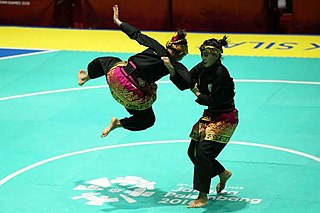
Kuntao or kuntau is a Hokkien term for the martial arts of the Chinese community of Southeast Asia, specifically the Malay Archipelago. It is most commonly practiced in and associated with Indonesia, Malaysia, the Philippines and Singapore.

The karambit or kerambit, kurambik or karambiak is a small Indonesian curved knife resembling a claw, associated with the Minangkabau people of West Sumatra. The karambit is one of the weapons commonly used in pencak silat and Filipino martial arts.
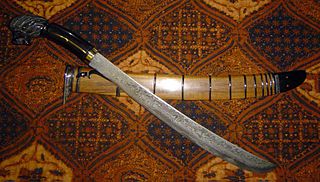
A golok is a cutting tool, similar to a machete, that comes in many variations and is found throughout the Malay archipelago. It is used as an agricultural tool as well as a weapon. The word golok is used in Indonesia and Malaysia. Both in Malaysia and in Indonesia, the term is usually interchangeable with the longer and broader parang. In the Sundanese region of West Java it is known as bedog. In the Philippines, the term gulok, refers to different dagger weapons including the kris.
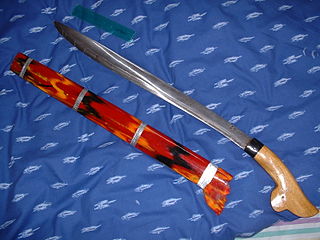
The parang is a type of knife used across the Malay archipelago.

Pencak silat is an umbrella term for a class of related Indonesian martial arts. In neighbouring countries, the term usually refers to professional competitive silat. It is a full-body fighting form incorporating strikes, grappling, and throwing, in addition to weaponry. Every part of the body is used and subject to attack. Pencak silat was practiced not only for physical defense but also for psychological ends. There are hundreds of different pencak silat styles and schools which tend to focus either on strikes, joint manipulation, weaponry, or some combination thereof.
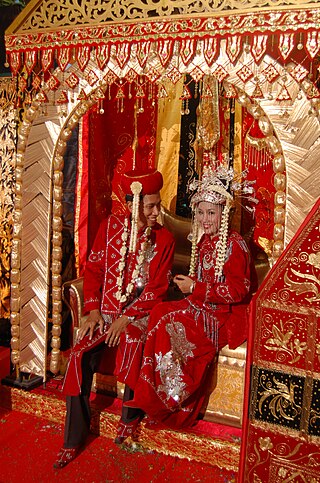
Betawi people, or Batavians, are an Austronesian ethnic group native to the city of Jakarta and its immediate outskirts, as such often described as the native inhabitants of the city. They are the descendants of the people who inhabited Batavia from the 17th century onwards.

The rencong is a type of knife originating in Aceh, Indonesia. Originally a fighting weapon, it is most often seen today in the martial art of pencak silat and worn during traditional ceremonies.

The kujang is a bladed weapon native to the Sundanese people of Indonesia. The earliest kujang made is from around the 8th or 9th century. It is forged out of iron, steel, and pattern welding steel with a length of approximately 20–25 cm and weighs about 300 grams. According to Sanghyang siksakanda ng karesian canto XVII, the kujang was the weapon of farmers and has its roots in agricultural use. It is thought to have originated from its predecessor, a kudi. The kujang is one of the traditional weapons in the Sundanese school of pencak silat. The kujang, like the keris, is a blade of sentimental and spiritual value to the people of Indonesia, who have a vast belief in supernatural powers.

The International Pencak Silat Federation, which was founded in Jakarta on 11 March 1980, is the only international Pencak Silat organization in the world. The International Pencak Silat Federation (IPSF) is the largest international governing body of competitive pencak silat with 66 member countries. IPSF is the only pencak silat organization recognised by the Olympic Council of Asia and has more than five million members. The IPSF organizes the Junior and Senior World Pencak Silat Championships, which are each held every other year. The President of the IPSF is Prabowo Subianto, and the headquarters are located in TMII, Jakarta, Indonesia.

A Celurit or Clurit is generally a sickle with a pronounced crescent-blade patterns which curves more than half a circle and a long handle, is widely used for agricultural purposes and also in Pencak Silat. When compared to the Arit, the Celurit is slightly larger.

Listed here are the weapons of pencak silat. The most common are the machete, staff, kris, sickle, spear, and kerambit. Because Southeast Asian society was traditionally based around agriculture, many of these weapons were originally farming tools.
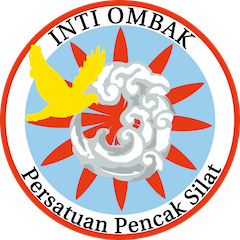
Inti Ombak is a style of pencak silat which blends martial arts descended from the Mataram Kingdom of Central Java with those hailing from the island of Madura. In English it is often abbreviated to IOPS, short for "Inti Ombak Pencak Silat". The Inti Ombak Pencak Silat Union is guided by three caretakers in accordance with the Javanese adage "In the front as a leader, in the middle as a moderator, in the back as an advocate". The current caretakers are Ki Poleng Sudamala of Yogyakarta, Daniel Prasetya of Colorado, and Tjahjadi Tanudjaya of Tengerang. The school's international headquarters are located in Yogyakarta, Indonesia while the US headquarters are in Ault, Colorado.

Sewar refers to a dagger of Indonesian origin, typically carried in a belt and used mainly in Sumatra, Indonesia. The blade is also referred to as Sewah by the Gayo people, Seiva by the Minangkabau people, Siva by the Alas people, and Siwaih by the Acehnese people.

A golok rembau is a type of golok in a shape of the tumbok lada, but in a larger version originating from Sumatra, Indonesia. It is also commonly found in Malaysia.

Indonesian martial arts includes a variety of fighting systems native to or developed in the archipelago of Indonesia, both the age-old traditional arts, and the more recently developed hybrid combatives. In the Indonesian language the term bela-diri is used to mean martial art, and in essence the Indonesian fighting arts are meant as one's defence against perceived threat and assault. Other than physical training, they often include spiritual aspects to cultivate inner strength, inner peace and higher psychological ends.

It is quite difficult to define Indonesian art, since the country is immensely diverse. The sprawling archipelago nation consists of 17.000 islands. Around 922 of those permanently inhabited, by over 1,300 ethnic groups, which speak more than 700 living languages.
Beksi Silat is one of the most popular traditional martial arts of the Betawinese. This kuntao-silat hybrid style was originally developed in Kampung Dadap, a village in Kosambi district of Tangerang Regency, Banten Province, Indonesia. The founder of this style combined elements of his ancestral Chinese martial arts with the silat knowledge he received from his Betawi teachers. The style spread through his disciples to the coastal Betawinese and the Benteng Chinese around Kampung Dadap. Eventually, the silat style also reached Petukangan Selatan in South Jakarta and Batujaya in Tangerang.
Cingkrik Silat is one of the traditional pencak silat styles of the Betawinese. This style originally came from the Rawa Belong area, which is now part of the Kebon Jeruk subdistrict, West Jakarta, Indonesia. This style was created by Ki Maing around the 1920s. Cingkrik Silat has now been spread to various places in Jakarta through many silat schools opened by its practitioners.
Perguruan Silat Mustika Kwitang, or simply called Kwitang silat, is a Betawinese pencak silat style. It was originally developed in the Kwitang village, which is now part of the Senen subdistrict in Central Jakarta, Indonesia. This style is a hybrid martial arts, developed by combining the local silat with the Chinese-influenced kuntao. The Mustika Kwitang Silat School was founded in 1945 by H. Muhammad Djaelani, who previously studied the martial arts from his own family.
Silat Sabeni Tenabang, often shortened as Sabeni silat, is one of the Betawinese pencak silat styles. The style was created by its eponymous founder Sabeni bin Canam around the end of the 19th century, when Indonesia was still in the Dutch colonial period. It was originally developed in the Tanah Abang district, now part of Central Jakarta, Indonesia.



















